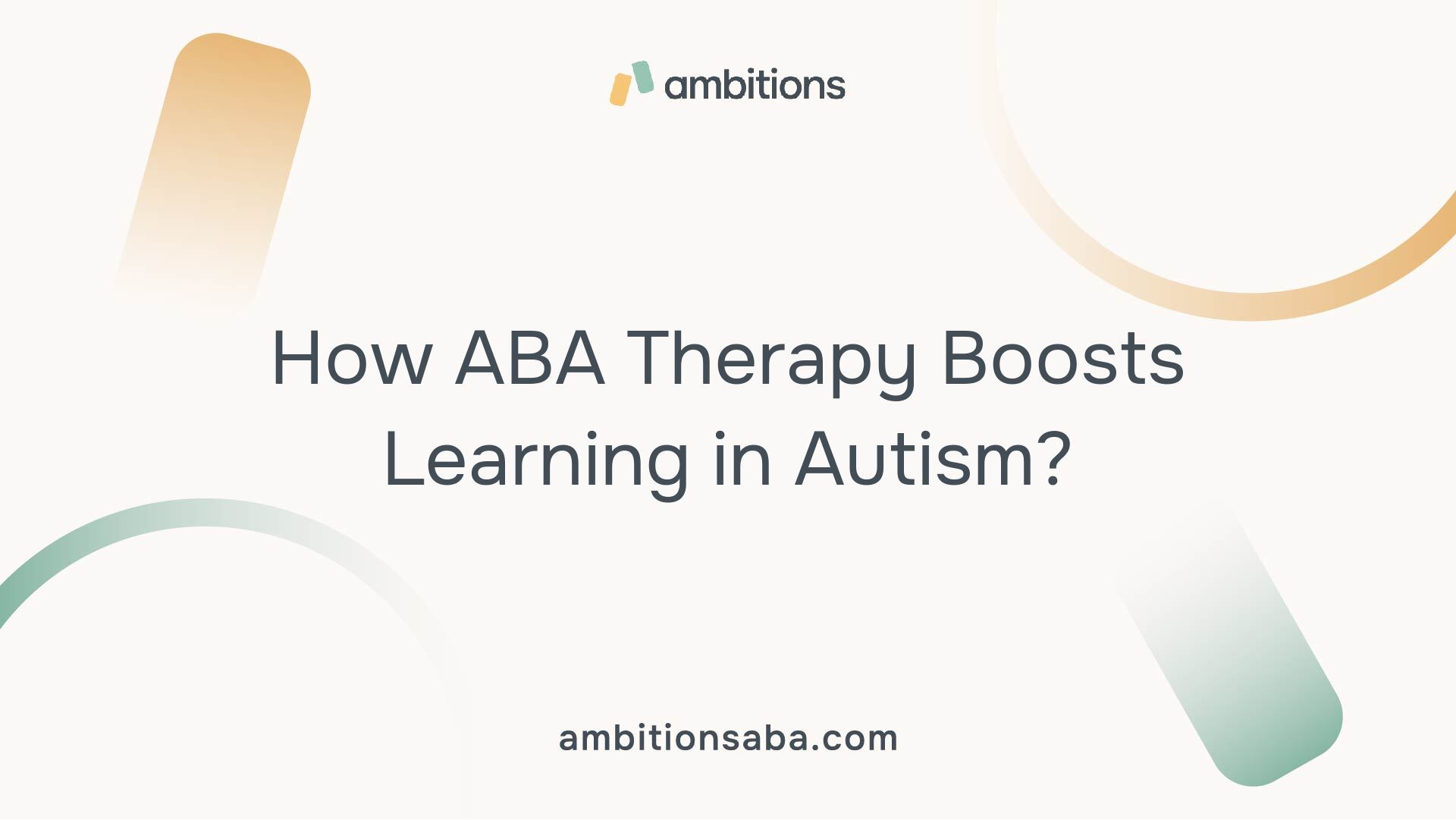How ABA Therapy Advances Language Skills in Children with Delays
Understanding ABA Therapy
ABA therapy plays a crucial role in enhancing learning for individuals with autism. It is an evidence-based approach that focuses on developing essential skills and behaviors necessary for everyday life.

Evidence-Based Treatment
ABA therapy is grounded in scientific principles and has proven to be an effective method for helping people with autism. This approach allows children to acquire skills that will benefit them throughout their lives, including the ability to communicate, interact socially, and develop independence. Many reputable organizations, such as Autism Speaks and the Association for Behavior Analysis International, endorse ABA therapy as a best practice for treating autism and learning disabilities.
The effectiveness of ABA therapy lies in its structured approach that rewards specific behaviors to promote positive changes. Each program is uniquely tailored to meet the needs of the individual, thereby focusing on enhancing suitable behaviors while reducing those that are harmful. Parental involvement in the treatment process is encouraged, allowing families to learn techniques that support skill development, leading to improvements in social skills and behavior, even in challenging environments [3].
Life Skills Development
The primary goal of ABA therapy is to promote essential life skills that enhance communication, social interaction, self-care, and academic performance. It has significant long-term effects on the core skills necessary for daily living.
Life Skill AreaABA Therapy ImpactCommunicationImproved expressive language and interaction skillsSocial InteractionEnhanced ability to engage with peers and familySelf-CareDevelopment of essential self-management techniquesAcademic PerformanceImproved focus and learning readiness
ABA therapy equips children with autism with the tools they need to successfully navigate their environments and interact with those around them. For more insights into how ABA therapy supports learning, referring to the article on how aba therapy enhances learning will provide additional helpful information.
Data-Driven Approach

ABA therapy uses a data-driven approach. This involves continuous data collection regarding a child’s progress, allowing therapists to adjust strategies and interventions as needed. This method ensures that the therapy remains effective and evolves according to the individual’s changing needs and progress [4].
Progress Monitoring
Progress monitoring is a vital component of ABA therapy. Regular assessments are conducted to track a child’s development over time. By breaking down skills into manageable steps, therapists can record advancements and the effectiveness of the techniques being used.
Assessment FrequencyDurationPurposeWeekly1 hourAssess skill acquisition and behavior improvementsMonthly1-2 hoursReview progress and plan adjustmentsQuarterly2-3 hoursComprehensive evaluation of overall development and strategy effectiveness
These assessments allow for timely modifications to the therapy plan if progress stalls, ensuring that the interventions remain aligned with the child’s evolving abilities. A focus on intensive and structured intervention, particularly more than 20 hours weekly during early years, significantly aids in reducing the need for special services later in life.
Intervention Adjustment
Intervention adjustment is essential in providing personalized therapy. ABA programs are tailored to meet the individual needs of each child, ensuring that strategies are flexible and can be modified based on ongoing assessments.
During therapy sessions, therapists closely analyze the data collected to determine the effectiveness of interventions. If a child is not responding to a specific technique, the therapist can pivot to another method that may yield better results. Regular reviews by a qualified behavior analyst are crucial in maintaining an optimal learning environment.
To enhance learning permanently, all findings and strategies are documented meticulously, enabling families to track their child’s journey. For additional insights, parents can explore resources on developing independence in autism and navigating healthcare for autism.
Behavior Reduction Techniques
When utilizing ABA therapy, behavior reduction techniques are essential for helping children with autism learn appropriate behaviors. These techniques involve identifying triggers that lead to problematic behavior and implementing proactive strategies to handle these situations effectively.
Identifying Triggers
Recognizing the specific triggers that lead to challenging behaviors is a critical first step in using ABA therapy. Triggers can vary widely among individuals and can include sensory overload, changes in routine, or social situations. By understanding these root causes, caregivers can develop targeted interventions to minimize the occurrence of such behaviors.
Using observational assessments, parents can track their child's behaviors alongside potential triggers, allowing therapists to design individualized support plans. This process not only helps in reducing problematic behaviors but also promotes healthier interaction patterns.
Trigger TypeExamplesSensory OverloadLoud noises, bright lightsChanges in RoutineAltered schedules, unexpected eventsSocial InteractionsNew people, large groups
Implementing personalized interventions based on trigger identification can lead to significant improvements in a child's ability to communicate and engage socially. Parental involvement in this process is crucial, as it aids in understanding what environments or situations might lead to difficulties [3].
Proactive Strategies
Proactive strategies within ABA therapy focus on preventing challenging behaviors before they occur. These strategies may include teaching alternative communication methods or coping skills for children to express their needs effectively. By equipping children with the tools to navigate their emotions and situations, the frequency and intensity of undesired behaviors can be diminished significantly.
Some common proactive strategies include:
These strategies are designed to promote positive behaviors while reducing the likelihood of challenging actions. By focusing on proactive approaches, parents can create a supportive environment that fosters learning and development. For more information on how these strategies can be effectively utilized, please check our article on how aba promotes positive behaviors.
Generalization of Skills
Generalization of skills is a key aspect of ABA therapy, allowing individuals with autism to apply what they learn in therapy sessions to everyday life. This transfer of knowledge is essential for fostering independence and enhancing learning outcomes.
Real-World Application
ABA therapy emphasizes the importance of learning skills that can be used in various environments, situations, and with different people. This focus on generalization ensures that the individual can adaptively function beyond the therapy room. Consistent application of learned skills in real-world settings supports better integration into society and improves overall quality of life.
Here's a breakdown of how generalization can occur in different domains:
DomainSkills LearnedReal-World ApplicationSocial SkillsInitiating conversationEngaging with peers at schoolDaily LivingCooking simple mealsPreparing food at homeCommunicationAsking for helpUsing clear speech with familyBehaviorManaging frustrationCoping strategies during outings
Adaptive Functioning
Adaptive functioning refers to how well an individual can manage day-to-day life tasks. ABA therapy plays a significant role in enhancing these skills, fostering independence and self-reliance among individuals on the autism spectrum. By targeting adaptive skills in therapy, children can develop competencies to navigate various situations effectively.
Consistent interventions, particularly when implemented for over 20 hours a week during early childhood, lead to significant developmental gains. This early intervention approach diminishes the need for special services later in life, further promoting adaptive functioning.
Adaptive functioning encompasses various areas, including:
Skill AreaSkills to DevelopReal-Life ImportanceCommunicationUsing functional languageAsking for assistance or expressing needsSocial InteractionParticipating in conversationsBuilding friendships and relationshipsDaily Living SkillsPersonal hygiene and self-careIndependence in daily routinesFunctional AcademicsBasic math and reading skillsManaging finances or reading instructions
Through ABA therapy, children with autism gain vital skills that help them interact successfully with their environment, thus enriching their capacity for learning and improving their overall developmental trajectory. For parents looking to support their child's learning journey, understanding how ABA therapy enhances learning is essential.
Benefits for Individuals with Autism
Social Skills Development
One of the key advantages of ABA therapy for individuals with autism is its focus on enhancing social skills. This type of therapy employs various techniques that promote social interaction and understanding, equipping children with the necessary tools to engage with their peers and navigate social situations. By utilizing positive reinforcement strategies, ABA therapy encourages the repetition of positive behaviors, leading to improved social interactions over time.
Social Skills AreasBenefitsInitiating ConversationsIncreases ability to start and maintain a dialogue with others.Understanding Social CuesEnhances the recognition of verbal and non-verbal signals.Building FriendshipsFosters the ability to form and sustain friendships.TeamworkPromotes collaboration when engaging in group activities.
These skills contribute significantly to a child's overall quality of life, leading to better socialization opportunities and experiences. For parents looking for guidance, socialization tips for kids with autism can provide additional strategies.
Communication Improvement
Communication is another fundamental area where ABA therapy shines. By focusing on essential communication skills, ABA helps children articulate their thoughts, needs, and feelings more effectively. The therapy employs various evidence-based techniques to support language development, ranging from verbal skills to non-verbal communication, such as using symbols or gestures for those who may be non-verbal.
A study found that positive reinforcement techniques used in ABA therapy lead to significant improvements in how children with autism communicate.
Communication Skills FocusBenefitsVerbal CommunicationEnhances speech clarity and vocabulary.Non-Verbal CommunicationDevelops alternative communication methods through gestures or symbols.Listening SkillsImproves understanding of instructions and feedback.Social CommunicationFosters the ability to engage in conversational exchanges.
Enhancing communication skills through ABA therapy creates pathways for more meaningful connections and interactions with others. Parents can further explore strategies through resources like autism communication tips for caregivers.
The cumulative benefits of ABA therapy, particularly in the realms of social skills and communication, provide substantial improvements in learning and overall well-being for children with autism. As they develop these core skills, they are better equipped to thrive in various environments, including home, school, and social settings.
ABA Therapy in School Settings
ABA therapy plays a significant role in educational environments, providing essential support for children with autism. This therapy not only enhances learning but also assists in developing vital skills necessary for success in school and beyond.
Behavior Strategies
In school settings, ABA therapy employs various behavior strategies to address challenges faced by children with autism. These strategies are designed to reduce behaviors that interfere with learning and improve overall classroom interactions. Some effective techniques include:
A combination of these strategies effectively teaches communication and social skills while creating a supportive learning environment.
Academic Support
Academic support through ABA therapy involves integrating evidence-based practices into the learning process. Behavior analysts work closely with educators to create individualized interventions that target specific learning goals for each student. This collaborative approach ensures that students receive the tailored support they need.
Some areas where ABA therapy enhances academic performance include:
Area of SupportDescriptionCommunication SkillsTeaching verbal and non-verbal communication strategies to express needs and interact with peers.Learner Readiness SkillsDeveloping attention, persistence, and independence to prepare students for classroom tasks.Academic SkillsFocusing on foundational subjects like reading, math, and writing, using structured learning methods.Social SkillsEncouraging appropriate peer interactions and group work through guided practice and reinforcement.
By employing these methods, school-based ABA therapy creates an environment that supports learners with diverse educational needs, enhancing not only their academic abilities but also their overall social development.
For additional insights on the impact of ABA therapy, visit our article on the impact of aba therapy on families.
References
[2]:
[3]:
[4]:
[5]:
[6]:
[7]:

